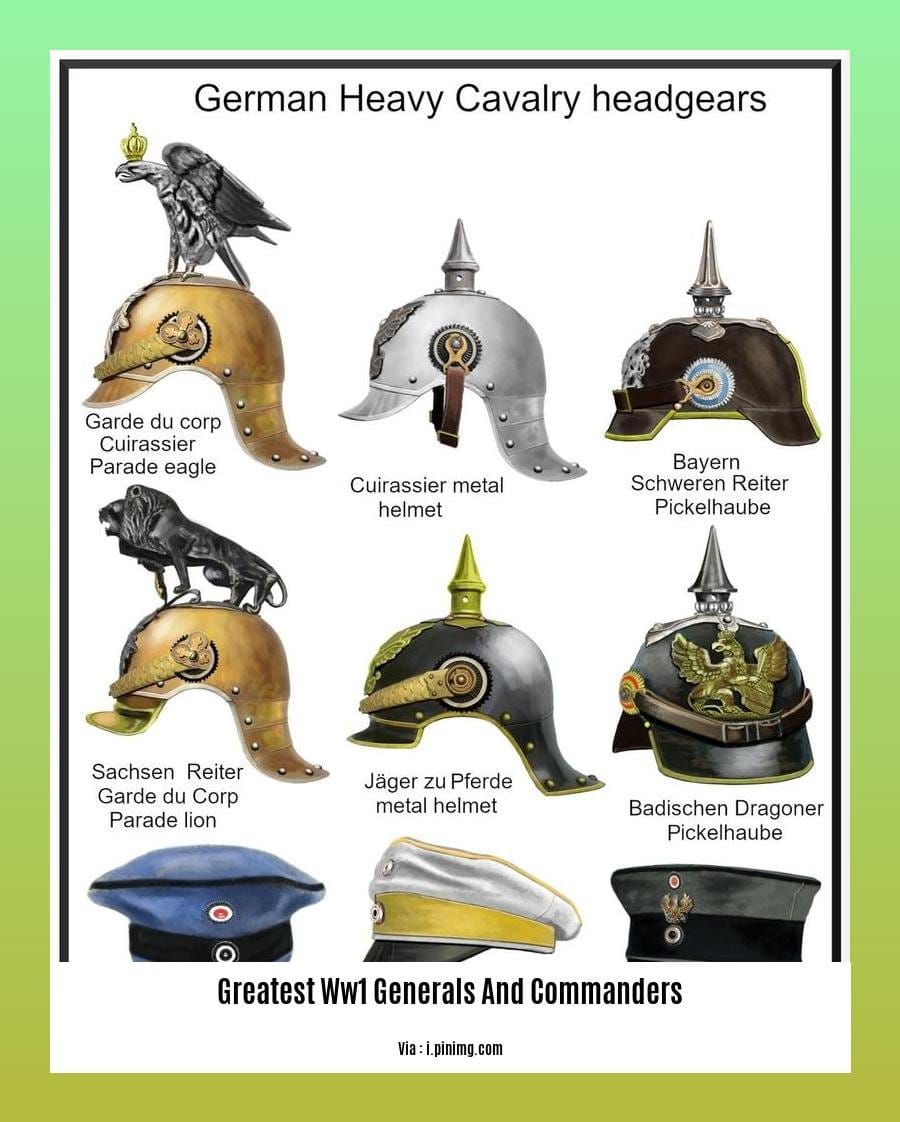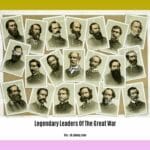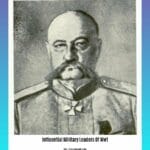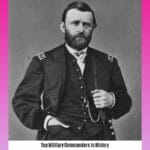Delve into the annals of World War I and encounter the exceptional military minds that shaped its course. The Greatest Generals and Commanders of World War I stand as titans of strategy, leadership, and battlefield prowess. Their names echo through the corridors of history, inspiring awe and admiration for their unwavering determination and strategic brilliance.
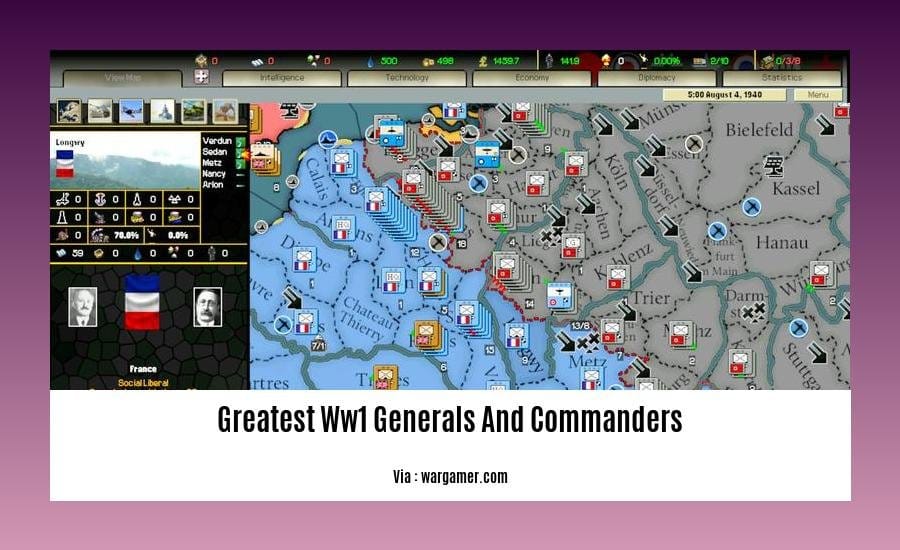
Key Takeaways:
- Philippe Pétain of France led the Battle of Verdun, one of the deadliest battles in history.
- Douglas Haig of Great Britain commanded the British Expeditionary Force, responsible for significant Allied losses.
- Armando Diaz of Italy secured victory at the Second Battle of the Piave.
- Živojin Mišić of Serbia halted Austro-Hungarian advances, contributing to the Serbian victory.
- Ferdinand Foch of France led the Allied forces to repel the German advance in 1914.
- Paul von Hindenburg of Germany commanded German forces on both the Eastern and Western Fronts.
- Paul von Lettow-Vorbeck of Germany led successful guerrilla warfare in Africa against Allied forces.
- John J. Pershing of the United States oversaw the American Expeditionary Forces’ involvement in the war.
- John Monash of Australia developed innovative tactics that improved Allied artillery and infantry coordination.
- Frederick Stanley Maude of Great Britain captured Baghdad in 1917, giving the Allies a strategic victory in the Middle East.
The Greatest WW1 Generals and Commanders
World War I, a cataclysmic conflict that forever altered the course of history, brought forth an assembly of the greatest WW1 generals and commanders. Their strategic brilliance, tactical prowess, and unwavering leadership left an indelible mark on the war’s outcome.
Erich Ludendorff: Germany’s Mastermind
The mastermind behind Germany’s early victories, Ludendorff was a military genius. His keen eye for strategy and tactical acumen led to triumphs at Tannenberg and Verdun.
Paul von Hindenburg: The Iron Hindenburg
Hindenburg, the embodiment of Prussian discipline, was a master organizer and administrator. His steadfast leadership and unwavering resolve kept Germany’s war machine functioning despite mounting setbacks.
Douglas Haig: Britain’s Tenacious Commander
Haig, a controversial figure, faced criticism for his relentless offensives. However, his determination and belief in his troops led to significant British victories, despite the heavy cost in lives.
John J. Pershing: America’s Organizer
Pershing, the commander of the American Expeditionary Force, was a brilliant organizer and tactician. Under his leadership, the AEF transformed from a raw force into a formidable fighting machine.
Henri Philippe Pétain: France’s Strategist
Pétain, a master strategist, orchestrated France’s defense against Germany’s relentless assaults. His leadership at Verdun and the Marne proved pivotal in repelling the German advances.
These extraordinary generals, along with countless others, shaped the fate of nations during World War I. Their courage, leadership, and strategic thinking left an enduring legacy on the annals of military history.
Explore the riveting tales of the leaders who changed the course of World War I and their profound impact on the war’s trajectory. Delve into the biographies of influential military leaders of WW1 (../influential-military-leaders-of-ww1) and discover their exceptional strategies and tactical brilliance. Immerse yourself in the captivating stories of legendary leaders of the Great War (../legendary-leaders-of-the-great-war) and witness their unwavering determination and indomitable spirit.
Douglas Haig (Great Britain)
Douglas Haig was the British field marshal who commanded the British Expeditionary Force (BEF) during World War I. His leadership has been both praised and criticized, with some historians crediting him with leading the British to victory and others arguing that his tactics led to unnecessary casualties.
Under Haig’s command, the BEF fought in some of the war’s most significant battles, including the Battle of Loos, the Attack of The Tanks, and the Battle of the Somme. Haig’s legacy as a military leader remains a subject of debate.
Key Takeaways:
- Haig was a controversial figure, with his leadership both admired and criticized.
- He commanded the BEF in some of the war’s most significant battles.
- His legacy as a military leader remains a subject of debate.
Citation:
- Douglas Haig – National Army Museum
John J. Pershing (United States)
Key Takeaways:
- Brilliant organizer and administrator who quickly built the American Expeditionary Force (AEF) into a formidable fighting force.
- Gifted tactician who led the AEF to victory in several key battles.
Biography and Military Career:
Born in 1860 on a Missouri farm, Pershing graduated from West Point in 1886. He gained valuable experience in Indian campaigns and the Spanish-American War. During World War I, Pershing’s leadership and organizational skills transformed the AEF into a capable force that significantly contributed to the Allied victory. Nicknamed “Black Jack” for his stern demeanor, Pershing is widely recognized as one of the great American generals of the 20th century.
Command and Achievements:
As commander of the AEF, Pershing oversaw the deployment of over two million American soldiers to Europe. He implemented rigorous training programs and emphasized discipline and efficiency within his ranks. Pershing’s strategic planning and battlefield tactics proved instrumental in Allied victories at the battles of Saint-Mihiel and Meuse-Argonne. He also played a crucial role in coordinating Allied operations and ensuring the smooth integration of American troops into the war effort.
Legacy and Impact:
Pershing’s leadership left an enduring legacy on the American military. He established standards of excellence that continue to shape training and operational procedures to this day. Pershing’s reputation as a military strategist and leader remains firmly cemented in the annals of American history, and he is widely regarded as one of the most skilled commanders of World War I.
Citation:
Henri Philippe Pétain (France)
A Commander of Great Significance
Henri Philippe Pétain, a revered French general, played a pivotal role in World War I. His strategic brilliance and unwavering courage earned him the title “Hero of Verdun.” Here’s a glimpse into Pétain’s remarkable achievements:
Verdun’s Savior: Pétain’s finest moment came at the Battle of Verdun, where he masterminded the tenacious defense against relentless German offensives. His innovative tactics and unwavering determination prevented a German breakthrough, earning him widespread acclaim.
Architect of Victory: Pétain’s strategic acumen extended beyond Verdun. He played a crucial role in the Allied counteroffensive that ultimately led to Germany’s defeat. His leadership and coordination helped secure a hard-fought victory.
Key Takeaways:
- Military Genius: Pétain was a master strategist and tactician, renowned for his innovative ideas and unwavering resolve.
- Symbol of Resilience: His leadership at Verdun epitomized the indomitable spirit of the French Army.
- Controversial Legacy: Pétain’s later collaboration with the Nazi regime during World War II tarnished his reputation.
Citation:

FAQ
Q1: Who were some of the most prominent generals and commanders in World War I?
A1: Some of the most prominent generals and commanders in World War I include Philippe Pétain (France), Douglas Haig (Great Britain), Armando Diaz (Italy), Živojin Mišić (Serbia), Ferdinand Foch (France), Paul von Hindenburg (Germany), Paul von Lettow-Vorbeck (Germany), John J. Pershing (United States), John Monash (Australia), and Frederick Stanley Maude (Great Britain).
Q2: What were some of the greatest victories achieved by these generals and commanders?
A2: Some of the greatest victories achieved by these generals and commanders include the Battle of Verdun (Philippe Pétain), the Battle of the Somme (Douglas Haig), the Battle of Vittorio Veneto (Armando Diaz), the Battle of Kolubara (Živojin Mišić), the Second Battle of the Marne (Ferdinand Foch), the Battle of Tannenberg (Paul von Hindenburg), the East African Campaign (Paul von Lettow-Vorbeck), the Meuse-Argonne Offensive (John J. Pershing), the Battle of Hamel (John Monash), and the capture of Baghdad (Frederick Stanley Maude).
Q3: What were some of the criticisms faced by these generals and commanders?
A3: Some of the criticisms faced by these generals and commanders include the high number of casualties suffered by their troops, the lack of innovation in their tactics, and their failure to achieve a decisive victory on the Western Front.
Q4: What were the key strategies and tactics employed by these generals and commanders?
A4: Some of the key strategies and tactics employed by these generals and commanders include the use of massed artillery, the development of new weapons and technologies, and the adoption of more flexible and fluid tactics.
Q5: What is the legacy of these generals and commanders?
A5: The legacy of these generals and commanders is complex and multifaceted. They were responsible for leading their respective armies to victory in one of the most destructive wars in history. However, they also faced criticism for the high number of casualties suffered by their troops. Their strategies and tactics have been studied and debated by military historians for decades, and they continue to influence military thinking today.
